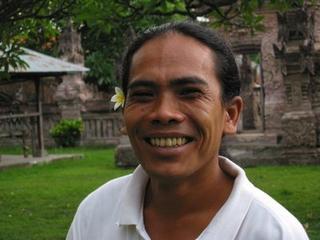 My warmest greetings from Bali!
My warmest greetings from Bali! My full name is actually I Wayan Suetayasa but I only use Wayan Sueta, as it is a lot easier for people to remember. The oldest of three brothers, I was born February 16th, 1973 in a small village called Taman on the west side of the sacred Ayung River in Ubud. As with most other kids in my village, I have lived there my whole life, first learning to farm and raise cattle from my grandparents. At the age of 9 my parents decided to register for a transmigration program to Borneo. Transmigration is a government program designed to move people from the over populated islands of Indonesia to sparsely populated areas such as Borneo, Sulawesi and Sumatra. My parents were interested in taking advantage of the resettlement program because, as an incentive, the government gave participants farmland. Since then I have been living in Bali with my grandparents. Although I only finished high school, as I could not afford to attend the university, I have continued studying English and other subjects on my own. To this day I regret having to let go of my dream to be a doctor. I consider myself to be a very positive person, and believe that if one has a dream for a better life, there is always a way to manifest it. Sometimes one has to give up one dream to achieve another.
I never aspired to be a guide, but I can say quite honestly that I am very proud of my vocation. I am proud to have a chance to share my beautiful country with people and introduce them to Bali's unique culture. I have been sharing the beauty of Bali with tourists from around the world since 1988, when I stated as a trekking guide. For a few years I took people on scenic hikes around Ubud to find its hidden beauty and to introduce people to the local villages and their way of life. It was a great time for me to brush up on my English, as I had a lot of opportunities to practice it during the leisurely walks through the lovely countryside. As I matured and became more proficient in my communication skills, I was tempted to share more about the island's beauty. This naturally led me to become a driver and guide, and in a short time I began taking people on wonderful tours all around the island.

Among the many rewards I have gained from being a guide is a renewed sense of pride and appreciation for the natural beauty and the incredible richness of its culture. I am eager to share all its beauty with everyone who wants to see and experience the real Bali. As someone who has spent my whole life living in the countryside, I know where to find the magical, hidden parts of the island as well as all the famous tourist resorts. I have also taken groups to other islands such as Lombok, Java, Borneo and Komodo, home of the famous Komodo dragons.
Backed by all the experience and knowledge that I have gained over the years, my goal is nothing short of giving my clients the ultimate vacation in Bali. I am proud to share all the beauty and mystery of my country with you so that you may bring home wonderful stories to tell your loved ones, and memories that will last a lifetime.
Anyway, I love making friendship with anybody around the world and sharing about our life, culture and other interesting stuff of our life. There are so much that we can share about this life even if we live thousands mile away across the great blue ocean but we can feel ourselves so close to each other with the love bind of pure friendship. I am pretty happy to share about my country with anyone who has any interest to learn and knowing about my beautiful island of Bali. I love taking photograph of nature and cultural events of my country and really love to share with everyone who has interest about it. I love outdoor activities like hiking, cycling, mount climbing and also love about art and painting.
Well, email me anytime on your convenience and we can start the exchange via the net and maybe we can see each other someday.
My warmest regards from Bali,

Wayan Sueta.
http://www.hiddenbali.com/


